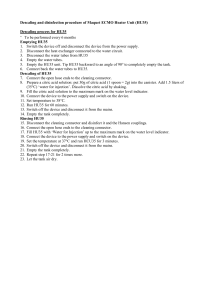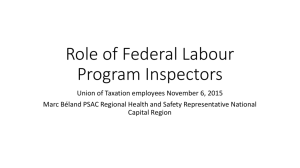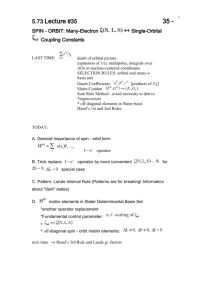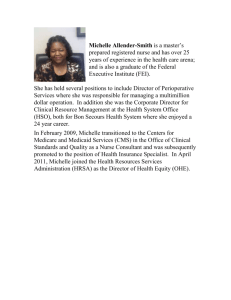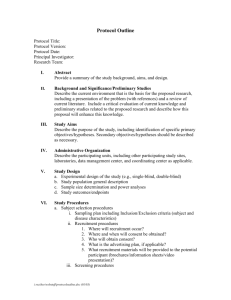Organizational Theory From a Transformational Perspective SOWO
advertisement
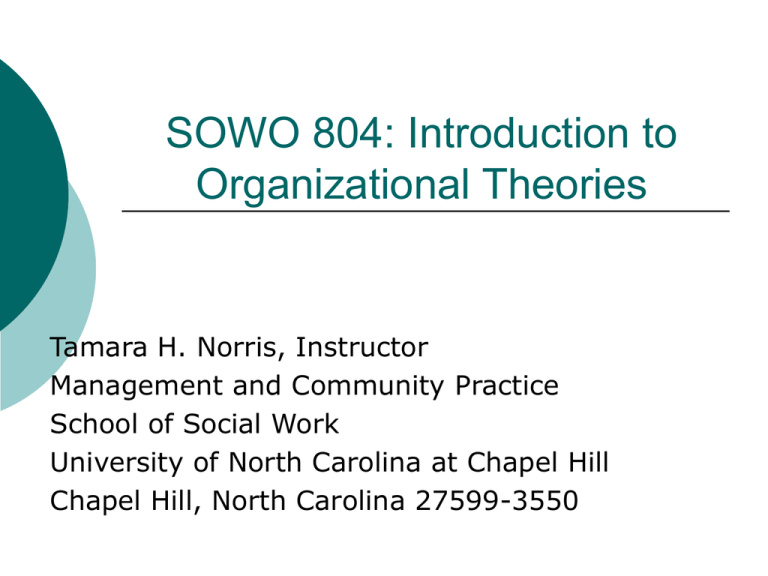
SOWO 804: Introduction to Organizational Theories Tamara H. Norris, Instructor Management and Community Practice School of Social Work University of North Carolina at Chapel Hill Chapel Hill, North Carolina 27599-3550 Nature of Human Service Organizations (HSOs) HSOs can be contradictory to clients and workers Workers have a goal to help people HSOs offer intrinsic and extrinsic benefits HSOs can also cause frustration Clients are the “raw material?” HSOs process, sustain, or attempt to change people Human Services as Moral Work Moral judgments and statements of social work Diagnostic labels----statements of social worth Allocation of resources: Rationing The Deserving Gendered Work Women have been historically assigned caretaker roles Patriarchal ideology---women as nurturers Women are the majority of frontline workers Conflict between women’s contributions to social work and HSO norms and values Devaluation of women’s work in human services: in earnings, positions, and social status----LONGITUDINAL SEXISM? Legitimacy issues: lack of resources, poor services often provided to clients who are mostly poor women The Primacy of Institutional Environment HSOs conform to dominant cultural, social symbols, and belief systems of “interest groups” in their environments HSOs’ access to resources is dependent on their adherence to environmental norms HSOs’ technical proficiency matters less than the ability to accommodate the escalating, often competing “diversity” in their service areas HSO rules and legitimacy are in flux Moral Entrepreneurs and Cyclical Legitimacy HSOs influence public perceptions of their clients: parents as partners consumers as potential welfare cheats Cycles occur within the communities of HSOs: Support for Aid to Families with Dependent Children (AFDC) 1996 Welfare Reform: Personal Responsibility and Work Reconciliation Act (PRWRA) PRWRA changed the perception of welfare from allowing “dependency” to mandating “work” Human Service Technologies as Enactment of Practice Ideologies Technologies are socially approved and sanctioned State Plans are best judgments of “best practices” that are frequently resourcebased Measures of effectiveness involve moral choices that are part of practice ideologies Effectiveness is also politically determined How so? Client Reactivity and Service Trajectory Clients can react and participate The reactions of neither clients nor staff can be completely controlled Many HSO services are compartmentalized and delivered in discrete ways The diagnosis of a client’s needs may not take into account his/her total ecology. Why is this so often so? Client Compliance Selection of clients who are amenable to services enhances control and responsibility Limiting and constraining client options improves tracking Social control is the result Is such control the best approach? Centrality of Client-Worker Relations Client-Worker relations are the core of HSOs The quality of these relations are critical to service delivery and successful outcomes Best cooperation is based on “trust!” But trust is impersonal and difficult to maintain due to the often irregular contact between HSOs and clients HSO Forms as Moral Practices: The Case of Welfare Departments Need to understand how HSOs select and implement moral rules that guide their work HSOs and their workers participate in this process (“micro interaction”) HSO rules are also driven by political interests (“macro interactions”) Moral assumptions are a constant in the welfare system Theoretical Approaches Rational-Legal Model (RLM) HSOs have a clear and specific set of goals and their internal structure and processes represent a rational design to attain them Internal divisions of labor, clear definitions of roles, and levels of authority are formalized The RLM cannot handle multiple and changing “environmental influences” Human Relations Approaches (HRAs) HSO effectiveness is a function of its goals and the personal needs of workers The quality of “leadership” is an important determinant of workers’ job satisfaction Burn-out is an increasing problem in today’s HSOs HRAs, alone, cannot overcome political and economic constraints Negotiated Order and Political Economy Work structures are a product of “negotiated order” among the participating actors (clients & workers) Services must have legitimacy, power, and resources (money, clients, and personnel) “Political economy” understates values and ideologies that transcend power and money in shaping HSO behavior Marxist and Institutional Theory Labor in HSOs is controlled through hierarchy, standard operating procedures, and the deskilling of jobs The market economy impacts HSOs Rules from the institutional environment determine the HSO structure Societal and HSO values are the driving forces HSOs uphold rules by coercion and/or imitation Population Ecology Groups and organizations that have similar characteristics and structure Focuses on the evolution of HSOs: founding, disbanding, and change in population Population ecology is sometimes inappropriately applied to HSOs and generates inaccurate interpretations of HSO environments Organizational Theory and Behavior Classical Organization Theory Scientific Management Theory (Taylor 1917) Four Basic Principles Find one “best way” to perform task Match each worker to the appropriate task Supervise workers, using “reward’ and “punishment” as motivators Management’s role is “planning and control” Organizational Theory (cont’d) Bureaucratic Theory Clear lines of “authority” and “control” Hierarchical structure of power Division of labor and specialization Rules for stability and uniformity Administrative Theory Emphasize universal set of management principles that can be applied to all organizations Neoclassical Organizational Theory Hawthorne Experiment Barnard (1968) Organization is a system of consciously coordinated activities Success depends on leader’s ability to create a cohesive environment Authority is derived from subordinate’s acceptance, not hierarchical power structure Neoclassical Organizational Theory (cont’d) Limited Rationality Model--Simon (1945) Workers may respond unpredictably to managerial attention The scientific method has to be rigorously applied Contingency Theory Chandler (1962) Form follows function Organizations act in a rational, sequential linear manner to adapt to changes in the environment. Ability to adapt=effectiveness Lawrence and Lorsch (1969) Managers should be given authority over their domain Systems Theory Ludwig von Bertalanffy (1928) All components of an organization are interrelated, changing one variable might impact many others These relationships can be nonlinear Nonlinearity=complexity Organizational Structure Systems Theory and Organizational Structure Relationship Patterns Among Organ. Parts Integration Differentiation Structure of hierarchical relationships Formalized policies, procedures, and controls Relationship Between Organization and Environment Complex environments=greater differentiation Two-way flow of information and energy Organizational Birth and Growth (cont’d) Cameron and Whetten (1983) Four Stages of Organizational Life Cycles Entrepreneurial Collectivity Formalization and Control Elaboration Land and Jarman (1992) Entrepreneurial and Bifurcation Reversal in strategy toward rule standardization Organizational Birth and Growth (cont’d) Child and Keiser (1981) Growth Can Occur in Four Organizational Models Striving for dominance with existing field/domain Diversification Technological Improved into new domains advancements managerial techniques Organizational Decline Biological Determinism( Boulding1950) Biological Life Cycle Irreversible trend toward death Peak and decline or never reach peak Signs of Decline Loss of morale, leadership, planning, innovation Conflict, secrecy, rigidity, scapegoating Conservatism, over-confidence Organizational Turnaround Biebault (1982)—Four Stage Model Change in management Evaluation Implementing emergency actions and stabilization procedures Return to growth Five Process Domains—Zammuto and Cameron (1985) Defense and Offense Creating new domains Consolidation and Substitution Final Theory Components The Learning Organization Continually enhancing ability to create Community (Godz 1992; Peck 1987) Organization acting as a community Organizational Morality (Senge 1990) (Adam Smith 1937) Accountability, amorality, legalistic, ethics
